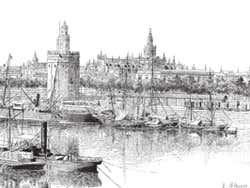
History of Seville
Seville is a city with a rich, passionate history, full of twists and curiosities, which has turned it into the charming, vibrant city it is today.
The Origins of the City
To this date, the origins of Seville are not entirely certain, although much like many cities, it has its legends. Some say that its origins are connected to the Tartessian culture, although the most accepted theory is that it was founded by Hercules, who then granted it to his son, Hispano, which led to it having the name 'Hispalis'.
According to the most credible version, the city was founded by the Tartessos community who lived in the Guadalquivir valley, and later it was populated by the Phoenicians, Greeks and Carthaginians.
In 205 BC, Seville was usurped from the Carthaginians by the Romans during the Second Punic War, and for two centuries it lived through the turbulent history of a Roman city.
In 43 BC, the city was taken by Julius Caesar, who changed its name to 'Lulia Romuela' or 'Romula', and it became one of the most important cities in the Roman province of Hispania Baetica, being Christianized towards the end of the empire.
After the fall of Rome, it was occupied by Silingi vandals, until they were banished by the Visigoths, who made the city one of the capitals of their kingdom. This was when one of Seville's most novel experiences took place: Hermenegildo betrayed his father, King Leovigildo and sieged the city, changing the river course.
Another memorable moment took place at the same time. During the banquet known as 'the supper of candles', the Sevillian nobles blew out the candles and made the most of the darkness to kill Gothic King Theudigisel.
Despite the Gothic capital being moved to Toledo, Seville's cultural importance was maintained with two important figures: Saint Leandro and Saint Isidoro. The emblem of Seville is of both bishops alongside King Ferdinand III.
In the year 712, Abd al-Aziz ibn Mussa took Seville and changed its name from 'Hispalis' to the Arabic 'Isbiliyya', which is where the name Seville is derived from.
In the year 715, the city became under the control of Cordoba.
When the Caliphate of Cordoba fell, hundreds of Taifas popped up all over Spain. In Seville, Abu I Qasim took power and started the Banu Abbad dynasty, paving the way for the Abbadid dynasty.
Seville's Golden Age
In 1091, the city was invaded by the Almoravids, and then by the Almohads a few years later. During the Almohad dynasty, Sevilla reached its utmost splendour and became the most important city in Spain. In this era, the Torre del Oro tower was built, as was the Great Mosque, of which the Giralda minaret still remains.
On 23rd November 1248, after a long siege, Seville was conquered by the Christian King Ferdinand III of Castile, and he made it one of the capitals of his kingdom.
In the 16th century some of the most important buildings in the centre of Seville were built, such as the Cathedral, the General Archive of the Indies, the Town Hall, the Casa de la Moneda, the University was founded, as was the Kingdom of Castile's first printing press.
At this point, the population reached 150,000 inhabitants, but its splendour was not complete and the city was not able to balance its accounts with the competition from Florence, Genova, Lisbon and the Netherlands.
On the brink of an economic disaster, Seville also suffered a demographic catastrophe with the Great Plague in 1649, causing its population to half and not recover until the 19th century.
During the counter-reformation, 73 convents were founded in the city, and this religious environment was the breeding ground for painters such as Valdés Leal, Murillo and Zurbarán, and sculptors Martínez Montañés and Juan de Mesa. Most of the city's churches, altarpieces and images of the famed Holy Easter Week that takes place each year also date back to this time period.
The Casa de Concentración (House of Trade) moved from Seville to Cadiz in 1717, resulting in the city losing a great deal of economic and political importance.
Resurging Stronger than Ever
In 1728 the Royal Tobacco Factory was founded in Seville, paving the way for the city's future. A century later the city started an expansion based on the building of railways.
During the 19th century, Spain played a huge role with regard to national politics: the Peninsular War, the revolutionary Junta of Narváez and Córdova, the uprising against Espartero, the riots because of O'Donnell's coup d'état, the revolution of 1868, and the Cantonal Rebellions in 1873. It was also an important hub of the CNT workers' union.
In the 20th century, Seville organised the Ibero-America Exhibition of 1929, a celebration which notably modified the image of the city.
Before the Spanish Civil War, Seville experienced large anticlerical movements. During the Civil War, it fell almost immediately to the nationalists and spent the rest of the war as a rearguard city.
Once the war finished, Seville suffered two sorrowful events: the Santa Bárbara gunpowder explosion on 13th March 1941 and the floods on 1st November 1961.
With the Statute of Autonomy, Seville became the capital of the Autonomous Community of Andalusia.
The Seville Expo '92 was another of the events that gave the city a major push, as new infrastructure prepared the city for the arrival of the 21st century.
At present, Seville is one of the most important cities in Spain.

